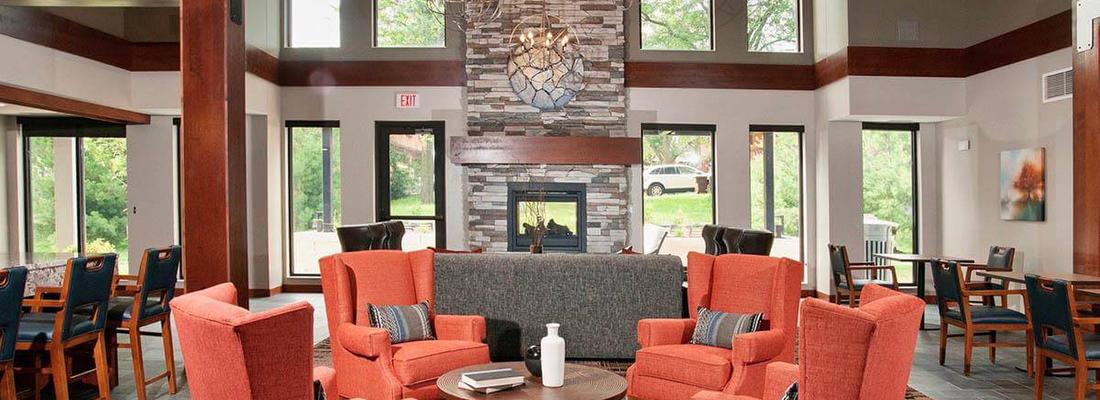
Most people are familiar with the Section 8 housing program for low-income housing. But several other programs exist to support the development of low-income housing. We like to use a program called Section 42 which provides a tax credit to build much-needed low-income, and often senior, housing across the country. Sometimes referred to as Low Income Housing Tax Credits (LIHTC), this program provides a way to drive investment in low-income housing.
Example of Success
 One property in our portfolio, The Grainwood in Prior Lake, Minnesota, offers a compelling example of a successful project. A four-story building built to feel like a Northern Minnesota lodge, this project showcases our ability to do craftsman style housing, but more importantly, provides a home for low-income seniors. We created the project for families with seniors (55+) in their household under the Section 42 housing program.
One property in our portfolio, The Grainwood in Prior Lake, Minnesota, offers a compelling example of a successful project. A four-story building built to feel like a Northern Minnesota lodge, this project showcases our ability to do craftsman style housing, but more importantly, provides a home for low-income seniors. We created the project for families with seniors (55+) in their household under the Section 42 housing program.
At The Grainwood location, we have a full-time on-site community manager who oversees the property and serves the community. (Read more on community management here.) The combined funding of public and private dollars allows us to provide needed housing for low-income seniors in Prior Lake, and provide homes that have nice amenities that seniors and their families enjoy living in. At The Grainwood, we feature walk-in closets, a washer, and dryer in unit, granite countertops, and more; all features suitable for people who have retired or are close to it.
Program Details
In Section 42 housing, residents must pay 100 percent of their rent, unlike Section 8 which offers a housing subsidy directly to residents. Residents’ income must fall below 60 percent of the area median income (AMI). At The Grainwood in Prior Lake, that means that a household of two people must fall below $43,440 and a household with four people must fall below $54,240. The AMI is determined at a county level by calculating median incomes across the area. With prices ranging from $939 to $1,297, we are able to keep the monthly rent residents pay under 30 percent of their income: the standard set for affordability by the federal Department of Housing and Urban Development (HUD).
Developers can choose, through Section 42, to gain more points on the application for tax credits by offering housing to seniors. A senior housing property can fulfill that definition either by providing housing intended for, and solely occupied by seniors over 62, or by ensuring that at least 80 percent of units are occupied by seniors 55+. Although certainly looser than the 62+ requirement, the 55+ designation requires clear advertising to state that the intent of the property is to provide housing for seniors and stricter requirements for the property itself. At The Grainwood, we chose to use the 55+ marker because it is an easier criterion to meet from an ongoing management and rental perspective.
Timeline
 We opened this property in summer 2017, but the success of the community was determined far beforehand. By winning Section 42 tax credits, this development was made viable by an influx of public dollars to provide for a pressing need in Prior Lake. This is a sought-after location, proving that low-income seniors in Prior Lake needed a community they are proud to call home.
We opened this property in summer 2017, but the success of the community was determined far beforehand. By winning Section 42 tax credits, this development was made viable by an influx of public dollars to provide for a pressing need in Prior Lake. This is a sought-after location, proving that low-income seniors in Prior Lake needed a community they are proud to call home.
Through Section 42 housing credits, the developer must comply with the eligibility requirement for 15 years, which means we will hold onto the property and manage it until at least 2032. Often as those 15 years come to an end, developers will enter an “extended use period” agreement which extends the requirements to a total of 30 years. This means that the financial restrictions for residents and the compliance restrictions (ex. who to rent to) remain in place for that period. Some developers choose to sell the property or offer units at market rate after the 15 or 30-year compliance period. At Dominium, our goal is to own our properties for the long-term. We reassess our portfolio before making any determination as we approach the end of a compliance period but we have a track record of owning many of our properties past the initial 15-years.

